- remind me tomorrow
- remind me next week
- never remind me
The X Button
Do the Mario
by Todd Ciolek,

Last week brought a bunch of Final Fantasy XIII news: a trailer showed off more of the game's increasingly ridiculous summoned machine-beasts, Square Enix unveiled the European and North American cover art, and Microsoft announced a baby-chocobo avatar available when you register here. All of this was dwarfed by the real news: Square's releasing Final Fantasy XIII perfume.
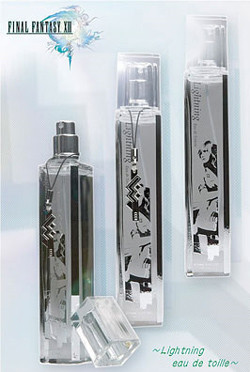
I found no evidence to support it, but I vaguely recall Square Enix putting out perfume for an older Final Fantasy, perhaps X or X-2. I'm pretty sure it wasn't Final Fantasy XII, because that game's dusty medieval atmosphere wouldn't leave anyone wanting to smell like an unshowered rabbit-woman or a thieving street urchin. Final Fantasy XIII, on the other hand, is a sleek, cleanly futuristic vision where even the bedraggled jungle warriors look like well-manicured models. And now you can smell like them.

And there's the official Final Fantasy XIII cover, just in case anyone cares.
NEWS
FALCOM PLANS A COMEBACK
In the early 1990s, Nihon Falcom was a major name in the game industry…well, the Japanese game industry, at least. It was there that Falcom's Ys series was nearly as big as Final Fantasy, inspiring many games, merchandise, and several thousand soundtracks. This didn't last, and Falcom has since lapsed into obscurity and repetition, putting out remakes of its more famous titles and the rare original game, like 2005's Gurumin.
But Falcom isn't sitting still. The company hopes to release more games in North America, particularly when it comes to the PSP. That's where many recent Falcom games have appeared, from Ys Seven to the recent dungeon-hack Brandish remake. The latest, a revamp of Ys III: The Oath in Felghana, is set to arrive on the PSP next year in Japan. Falcom shouldn't have too much of a problem getting U.S. publishers interested, as Atlus published Ys I and II for the DS this year.
 Perhaps the most interesting piece of Falcom's 2010 lineup is Ys vs. Sora no Kiseki, a PSP fighting game that draws from at least two major Falcom franchises. Resembling Dissidia: Final Fantasy more than a little, the game pits characters from both series against each other in 3-D arenas full of warping panels and easily destroyed objects. The final cast will supposedly feature over 40 characters, though only six are confirmed so far. Ys supplies hero Adol, his sidekick Dogi, and Olha, the elf-like islander from Ys VI. Sora no Kiseki, known as The Legend of Heroes over here, gets the sixth game's Joshua, Tita, and Estelle.
Perhaps the most interesting piece of Falcom's 2010 lineup is Ys vs. Sora no Kiseki, a PSP fighting game that draws from at least two major Falcom franchises. Resembling Dissidia: Final Fantasy more than a little, the game pits characters from both series against each other in 3-D arenas full of warping panels and easily destroyed objects. The final cast will supposedly feature over 40 characters, though only six are confirmed so far. Ys supplies hero Adol, his sidekick Dogi, and Olha, the elf-like islander from Ys VI. Sora no Kiseki, known as The Legend of Heroes over here, gets the sixth game's Joshua, Tita, and Estelle.
While both Ys and The Legend of Heroes have huge casts of characters, it's short-sighted for Falcom to draw from just two series. The Falcom catalog is massive, and a company-wide fighter would be much more interesting if it included the giant cat-monster from Gurumin, medieval brawler Umber Galsia (or Amber Garcia, for those of you who prefer logical translations) and ninja-guy Jinza from Brandish 3, and Mail, Tatt, Gaw, and…well, everyone from Popful Mail, actually. Get on that, Falcom.
NO MORE HEROES SEQUEL RATED, PREVIEWED
The ESRB exists to slap labels on games, but they're often quite thorough when it comes to creatively gruesome offerings like No More Heroes: Desperate Struggle. The board's description of the game mentions all sorts of blood-drenched displays and misogyny, even accounting for the filthy magical-girl cartoon that pseudo-hero Travis Touchdown follows. You can read the full description here, but my favorite part is the last sentence: “The battery meter for Travis's sword is always represented by a cartoon-like penis icon in the upper-right corner of the screen: as battery power runs out, the icon starts to shrink—a sad face appears.”
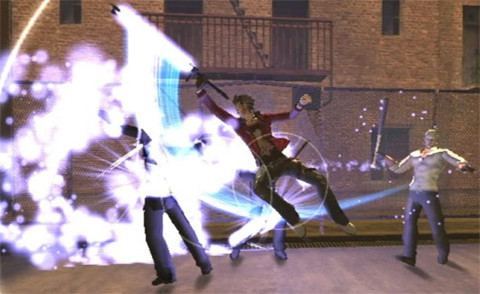
No More Heroes: Desperate Struggle is scheduled to make a shameless mockery of nerd culture this January.
ATLUS SHILLS SHIREN
The DS version of Shiren the Wanderer was arguably the best-loved dungeon hack of last year's microcosmic dungeon-hack craze, and while Sega isn't picking up the Wii-based sequel, Atlus is more than willing to grab it and promote it in official YouTube trailers.
IN BRIEF: ATLUS DOES TOKYO MAJIN, PHOENIX WRIGHT DOES WII
Remember Tokyo Majin, the anime series based on a video game franchise that's entirely unknown in the U.S.? You might, but that anime wasn't too memorable, was it? Anyway, Atlus is making Japan's next major Tokyo Majin game: Tokyo Mono Hara Shi for the PSP. It's a text-heavy adventure game with some RPG elements, and Tokyo Majin's habit of pitting high-schoolers against demons might conjure up similarities to Atlus' own Shin Megami Tensei series. It also stands a slight chance of coming to the U.S. through Atlus, and that's more than can be said for any other Tokyo Majin title.
One reader has dutifully reminded me for two weeks that the first three Phoenix Wright games are coming to WiiWare, so I'd better mention them now. They're the same dialogue-driven courtroom dramas that they were on the DS, though the Wii interface resulted in this, which I hope is not some jokester's Photoshop.
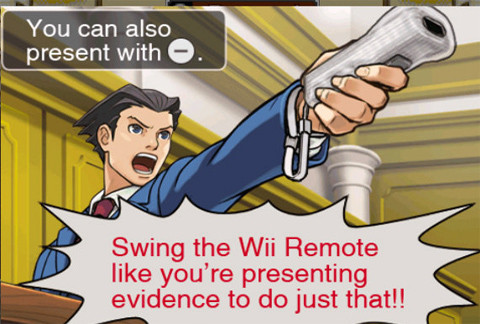
The Phoenix Wright trilogy will hit WiiWare this spring, with the last game carrying an “extra episode.”
In news that only I care about, the amazing Cave shooter ESPgaluda II Black Label will arrive on the Japanese Xbox 360 in February. No one's said if it'll be region-free like Cave's recent Mushime-sama Futari, but I really hope it is.
REVIEW: NEW SUPER MARIO BROS. WII
 Developer:Nintendo
Developer:Nintendo
Publisher: Nintendo
Platform: Wii
Players: 1-4
MSRP: $49.99
Some Super Mario Bros. fans will never be happy. They're the ones who insist that the Super Mario Bros. games peaked somewhere around Super Mario Bros. 3 or Super Mario World, and that all modern successors are doomed to inferiority. In their bitterness, there's a hint of truth, as Nintendo rarely makes Mario games with the same traditional 2-D focus as the older titles. Super Mario Galaxy and Super Mario 64 are impressive but largely 3-D beasts, and the DS-based New Super Mario Bros. was disappointingly bland. New Super Mario Bros. Wii is different, though. It's the first time Nintendo's made a new Mario game with the best of all that came before it, and it's a resounding success.
In its tributes to past Mario games, New Super Mario Bros. Wii begins, quite naturally, with the abduction of Princess Peach by not only Bowser but also Bowser Jr. and the Koopalings, who haven't done much since Super Mario World. The game's various worlds are laid out as maps, with enemy encounters, toadstool houses, castles, ghost houses, airships, and any other scrap of Mario lore worth preserving. Most welcome is the Super Mario Bros 3 idea of gathering power-ups and using them on the map.

The gameplay takes a similar all-inclusive approach. Mario's simple, two-dimensional running-and-jumping is expanded with countless ideas from past games: carrying objects, bouncing off walls, stomping blocks and enemies from above, shrinking to half-size with a special mushroom, and so on. Yet there's also a wealth of new concepts, and the game wastes little time in introducing them. An ice-themed flower joins the traditional Mario fireflower, allowing Mario to shoot ice-balls that freeze enemies into solid, easily carried blocks. A propeller hat, activated by physically shaking the Wii remote, gives Mario bursts of flight and diving attacks. And then there's the penguin suit. It lets Mario belly-slide across ice, efficiently tread water, and fire off ice-balls. It's the best Mario outfit since Super Mario Bros. 3's Hammer Bros. Suit, and it's a shame that the penguin suit doesn't show up in every last New Super Mario Bros. Wii level.
New Super Mario Bros. Wii's minor expansions of Mario's repertoire are novel, but the game truly excels in level design. It's never at a loss for new ideas, right from the first stage's rolling hills, or clever twists on old Mario standards. Original challenges appear in each world, whether it's a leap across expanding platforms or a race against plummeting pillars that slam sideways across the entire level. Many of the tasks are entirely optional, such as the game's habit of putting captured mushroom-hatted Toads in previously cleared stages. Players must replay the level, find the Toad in a question-mark block, and carry him/her/it through the rest of the stage, making for a far more difficult play-through.
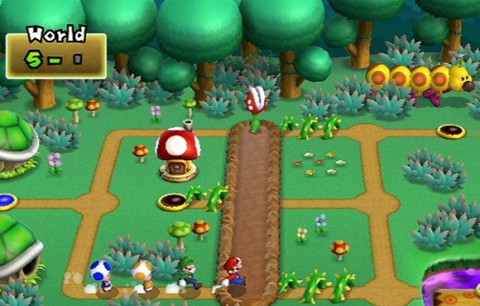
Familiar sights, from the angry caterpillars to the Cheep-Cheep fish, become new hazards throughout the game, and it's all marvelously comforting to anyone who sat down and played through a Mario game as a kid. And for the newcomer who's somehow avoided Mario games (and presumably all games, period) up to now, New Super Mario Bros. Wii is very approachable. Basic visual hints guide players through the game's new moves, and everything's easy to learn.
Built with 3-D visuals atop distinctly two-dimensional gameplay, New Super Mario Bros. Wii isn't all that striking in appearance. Instead of hurling giant spinning helicopters at the player for no reason, it impresses by pulling off visual tricks that actually enhance the gameplay. It's also hard to criticize a game's looks when its enemies dance to the music; let the Koopa turtles walk around and you'll see. On that point, the new music is solid but not quite as memorable as the Super Mario Galaxy soundtrack, though the remixes of Mario themes are comfortably nostalgic. It makes one realize that the “underground” Mario beat might be the most recognizable tune in any video game.
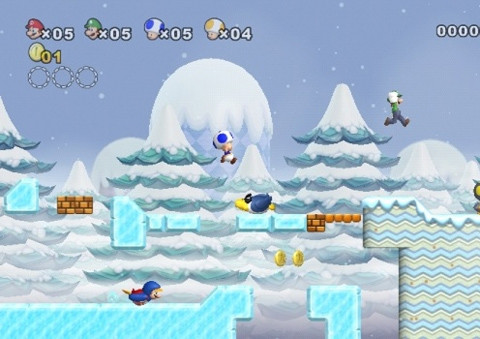
New Super Mario Bros. Wii isn't without a few problems. It often seems awkward to shake the controller to lift objects or fly, especially when past Mario games pulled off similar maneuvers without remote-waggling demands. The game's four-player mode, in which Mario is joined by Luigi and two Toads, also presents flaws. It's fun, but why isn't it available via online play? And why is the fourth character just another Toad instead of Princess Peach or Daisy? Supposedly dress-based physics kept Nintendo from including them, as New Super Mario Bros. Wii is set in the days before women were legally allowed to wear pants. Lastly, New Super Mario Bros. Wii presents a new Nintendo-backed idea: if you fail to complete a world eight times, you can bash a green block and have the computer finish it for you. It's a bit insulting, but at least it's completely optional.
It's easy to get caught up in hyperbole when a Mario game does well, as old magazine covers extolling Super Mario 64 as “The Greatest Game Ever” can attest. Yet New Super Mario Bros. Wii truly is one of the best games of its kind, a running, jumping, mushroom-eating, turtle-stomping, side-scrolling, penguin-imitating masterwork that'll bring any erstwhile Mario fan right back around. It's essential for anyone who's ever enjoyed Nintendo's biggest crowd-pleasing series.
RELEASES FOR THE WEEK OF 12-6
THE LEGEND OF ZELDA: SPIRIT TRACKS Developer:Nintendo
Developer:NintendoPublisher: Nintendo Platform: DS Players: 1 MSRP: $34.99
Some may laugh at the latest Zelda game focusing on a train, but I suspect most of those people jumped ship when The Wind Waker turned Link into a cel-shaded kid back in 2003. Spirit Tracks carries the look of Waker and the DS-based Phantom Hourglass, though it strikes off into new territory. The train itself is mere transportation for Link as he and the disembodied spirit of Princess Zelda set out in search of her abducted physical form. While Link navigates dungeons and solves puzzles (many of which will surely involve novel uses of the DS stylus), Zelda can move through narrow confines and possess various creatures. It's technically the first time Zelda's been playable in the series, not counting the Smash Bros. titles and those two CD-I games. Yes, those two.
|
SILENT HILL: SHATTERED MEMORIES Developer: Climax Studios
Developer: Climax Studios Publisher: Konami Platform: Wii Players: 1 MSRP: $49.99
The original Silent Hill was perhaps the first survival-horror game to stand apart from Resident Evil's cheese fondue of a movie tribute, though it's now outpaced by at least two of its sequels. That's why Silent Hill: Shattered Memories revamps the original's storyline with some current touches. Harry Mason is still a somewhat average guy searching for his daughter in a town full of fog and shifting dimensions, but Shattered Memories gives him a cell phone with a GPS system, text messaging, a camera, and all of those other things the kids are using nowadays. The Wii version, shipping well before the PSP and PlayStation 2 get theirs, uses the remote to control both the cell phone and Harry's flashlight, echoing the game's shift away from battling monsters. Most interesting is the game's opening rigmarole of questions, which get quite personal and change the experience in many subtle ways.
|
EXTRA LIVES: FALCOM ANIME
Today's anime-infused game nerd might not know much about Nihon Falcom, as the game developer fell out of the industry spotlight in Japan many years ago. Yet Falcom's an important part of this niche's history. Long before Nippon Ichi Software and Atlus and Gust and other companies were bringing anime fans and RPGs together, Falcom was marrying the two worlds for fun and profit.
YS
Ys, always sure to spark arguments over pronunciation, is Falcom's flagship series. First arriving on Japanese computers in the 1980s, the original Ys and its sequel were promptly ported to nearly every major game system in history. Though their gameplay is based around a primitive system of simply running into enemies, the Ys games once set bold new standards for visual design, anime-style storytelling, voice acting, and music. In the U.S., the series was best known through Ys Book I and II, which made many owners of the Turbografx feel better about blowing hundreds of dollars on CD drives for their systems. Ys has many fans despite its lack of evolution, and the original game's soundtrack, by Yuzo Koshiro and Mieko Ishikawa, is still downright amazing.
Of course, Ys inspired anime series. The games' stories, usually about silent adventurer Adol and the ancient civilizations he uncovers, seem far less compelling when made to stand on their own, but Ys still managed to fill two OVA series by adapting its first two games. And in the golden age of reckless anime licensing (2000-2004), Media Blasters brought both series to America.
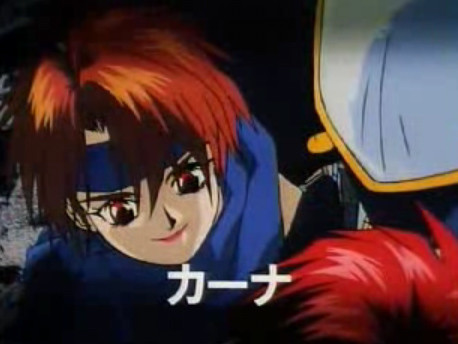
The most interesting relic of the Ys anime is a trailer for an Ys IV: The Dawn of Ys series that never materialized. Perhaps predicting the franchise's slight fall in popularity, the trailer was shopped around to production companies that just didn't bite.
DRAGON SLAYER
Not to be confused with the hokey 1981 fantasy film, Falcom's Dragon Slayer series encompasses several other game lines, including Lord Monarch, Sorcerian, Xanadu, Faxandu, and Legacy of the Wizard (the last two of which were thrust upon American NES owners). A somewhat generic RPG series, Dragon Slayer followed in Ys Book I and II's footsteps by providing anime-themed grandeur to starved Turbografx and TurboDuo owners in the early 1990s. This gave Dragon Slayer little recognition among American fans, but an anime OVA based on the series nonetheless hopped over here courtesy of Urban Vision. It's a standard fantasy deal, though character designer Ken Ishikawa's style sometimes makes it look like a lost Go Nagai creation.
POPFUL MAIL
When it comes to Falcom and the anime element, there's one game that stands above all others: the Sega CD version of Popful Mail. Like most Falcom games, Popful Mail went through several different versions, but it was on the Sega CD that it truly found its art. Sega originally planned to reprogram it into a Sonic game starring a female character, but Popful Mail remained a Falcom title due to fan outcry and internal Sega laziness. And it was all for the better. A lightweight side-scroller with RPG mechanics beneath its surface, Popful Mail mockingly follows a mediocre and money-hungry swords-elf named, well, Popful Mail as she hunts bounties and eventually saves the world alongside a naïve wizard and a pudgy little cave-dragon. She also casually insults everyone she meets.
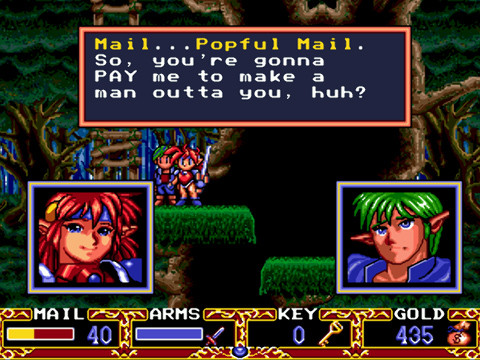
For its trip to America, Popful Mail was localized by Working Designs, known for completely recasting games with goofball comedy and spikes in difficulty. This led to many complaints from purist gamers, but Working Designs' approach worked wonders for Popful Mail. Never a serious game to start with, Popful Mail is strewn with lovably dumb characters and ridiculous plot twists, and it's no stretch to drop Schwarzenegger references and tough-talking penguin kings amid all of the anime nonsense. Working Designs also toughened up the game considerably, making it last far longer than the pushover Japanese original.
Falcom has since forgotten about Popful Mail. The series spawned some drama CDs that inexplicably paired Mail with cutesy girl sidekicks, but that was as far as it went. Perhaps it's somewhere on Falcom's list of games to remake, but fans in search of the best Popful Mail will have to make do with the sought-after Sega CD version for now.
discuss this in the forum (47 posts) |
this article has been modified since it was originally posted; see change history